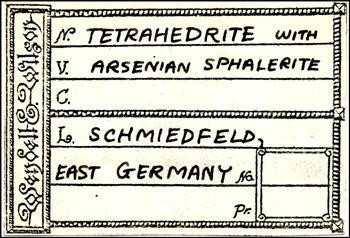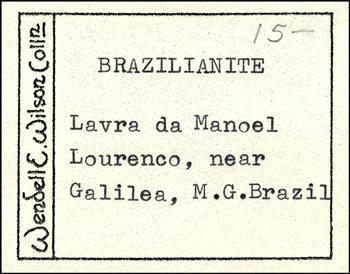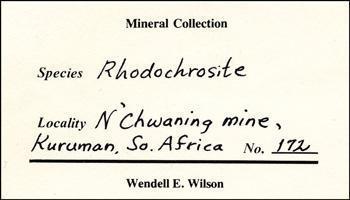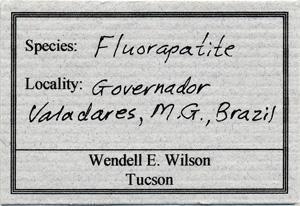Wilson, Wendell E. (1946- )
Wendell Eugene Wilson was born in St. James, Minnesota on November 13, 1946, the son of Wendell Wilson, Sr., an electrical engineer and corporate CEO, (see Wilson family history click here) and Lorraine (Haseman) Wilson, an artist and poet. He grew up in the Minneapolis suburb of Bloomington where he excelled as an artist and won numerous awards for his work. While vacationing with his family in Duluth, Minnesota, he discovered a fascination with minerals at the age of ten while hunting agates along the shore of Lake Superior; this led him to Adeline's Rock Shop in Duluth and to Leo "Rocky" Quinn at the Beaver Bay Agate Shop. From then on, his two passions in life were minerals and art.Wendell attended the University of Minnesota at Duluth, graduating with a double major in Geology and Fine Art in 1969, and a minor in Physical Sciences (Physics, Chemistry, Math). Eager to see rich mineral country, he turned down an acceptance to Graduate School at Yale and instead enrolled at Arizona State University in Tempe. He specialized in meteorite mineralogy at the Center for Meteorite Studies, and was awarded his Master's Degree in Mineralogy in 1972. While in Arizona he collected extensively at many of the state's most famous localities, including the Apache, Rowley, Ray, Old Yuma, Harquahala, Silver Bill, Silver Hill, Defiance, Mystery Tunnel, Inspiration, Magma, Red Cloud, Camp Verde, Florence, Grand Reef and 79 mines, among others. A specimen of aurichalcite that he collected at the 79 mine (now in the collection of the Arizona-Sonora Desert Museum) remains the finest known example of the species.
Returning to Minnesota, Wendell enrolled in the PhD program at the University of Minnesota in Minneapolis, where he specialized in isotope geochemistry, Lunar petrology and mineralogy with a minor in Museum Science. He spent a summer in Washington, DC working at the Smithsonian Institution under Brian Mason (at that time Head of the Mineral Sciences Department), Paul Desautels (curator) and John White. In the daytime he studied lunar minerals under a grant to Brian Mason and studied museum science in general to complete requirements for an academic minor in that field. In the evenings he worked late in the Mineral Sciences Department refining his skill at mineral photography. He published his first article (on the Apache mine) with the Mineralogical Record in 1971, and was appointed Associate Editor in 1973. That same year he married his college sweetheart, Carolyn Wiese.
Upon receiving his PhD in 1976, and finding there were no curatorial positions then open in the field of mineralogy, he was immediately hired by John White to take over the editorial duties for the Mineralogical Record magazine. His efforts to revamp the struggling journal were successful, nearly doubling the circulation in his first year. In 1977 he produced the first of many oversized book-style issues, this one devoted to the Tsumeb mine in Namibia. It caused a sensation, and in 1982 a new Tsumeb mineral species was officially named minrecordite (the only species ever to be named after a journal), in recognition of the journal's achievements as "a worthy magazine in promoting both a better knowledge of Tsumeb minerals and a more beneficial interaction between amateur and professional mineralogists." In 1983 White stepped down and Wendell took over the duties of Publisher/CEO as well, positions he still holds today.
Wendell's personal bibliography (CLICK HERE) is extensive: He is author or co-author of over 200 major articles and 13 books in mineralogy (his most important work: The History of Mineral Collecting 1530-1799), plus over 350 column installments. He has also published 18 articles and books on mining history (favorite book: A Collector's Guide to Antique Miners' Candlesticks, the definitive work on a complex subject). In addition he has supervised the production of dozens of special-topic or book-length publications of the Mineralogical Record, including museum catalogs for the Houston Museum of Natural Science and the Carnegie Museum of Natural History, a book on the history of mineralogical literature (also co-author), a book on Classic Minerals of Northern England (also co-author), a series of six special issues on the Mines and Minerals of Mexico (also co-author), a book on Private Mineral Collections in Texas, another on Private Mineral Collections in Italy, as well as sevberal other regional books on collections, ten successive editions of the Glossary of Mineral Species, the Glossary of Obsolete Mineral Names, the International Mineralogical Association's World Directory of Mineral Collections, and other important works. During his long career as editor, Wendell has overseen the publication of 30,536 pages of mineralogical information for collectors and mineralogists worldwide.
Wendell is among the world's leading mineral photographers, with over 6,500 published photos. The Carnegie Museum's Marc Wilson says that Wendell helped "set the standard" for modern publishing-quality mineral photography." Likewise the book Grandmasters of Mineral Photography (2004) lists him as the earliest of all those included (and the mentor of several). He has served as photo editor for Encyclopedia of Minerals (1987) and Mineralogy of Arizona (1995), and contributed over 3,400 photos to the Los Angeles County Museum of Natural History's Photo-Atlas of Minerals (2000).
As a well-known mining-and-mineral artist Wendell (click here) (and click here) has over 1,000 published artworks in a variety of mediums. His mineral specimen paintings have been cherished by top collectors for years, and his fantasy underground collecting scenes (issued as a series of numbered prints) are widely collected.
Wendell, who is also an authority on antiquarian mineralogical literature, founded the Antiquarian Reprint Series as a method of preserving and distributing facsimile reprints of very rare, early illustrated mineral books. Eleven works have been published so far; his favorite is Gautier d'Agoty's Histoire Naturelle Regné Mineral (1781), of which no complete copy has survived, but Wendell assembled one from surviving parts in different libraries to make a complete reprint. He is also the founder of the Mineralogical Record Library, one of the most important collections of early mineralogical literature in the country. And he is the founder of the online mineralogical journal Axis ("An Eclectic Journal of Mineralogy"), the online Mineralogical Record Museum of Art and the online Mineralogical Record Biographical Archive, an archive of over 1,800 biographies of mineral collectors, dealers, mineralogists and mineral museums.
The new species wendwilsonite was described in 1987, and named after Wendell "in recognition of his contributions to mineralogy." He is the 2001 recipient of the Carnegie Mineralogical Award, is a Fellow of the Mineralogical Society of America (1989) and a Senior Fellow of the Geological Society of America (1995), has served as an Advisor to the Board of Trustees of the Arizona-Sonora Desert Museum (1988-1990), and is or has been a member of the Geo-Literary Society, the Mineralogical Association of Canada, the Mineralogical Society (of Great Britain), the Friends of Mineralogy, the Tucson Gem & Mineral Society, the Mineralogical Society of Southern California, and the American Society of Media Photographers.
Wendell sold his earliest mineral collection, primarily a species collection, in 1974 and started anew on higher quality specimens. In some cases (in this second collection) he glued a small 1-cm label to the back of his specimens, giving only his name, the catalog number and the year of acquisition. Many of these are identifiable on the specimen market today, though they may have long since become separated from their larger label. The second collection was sold in 1991, and a third collection was started in 1994; it continues today. It currently numbers about 350 specimens, primarily high-quality thumbnails but also including many fine miniatures anda few small-cabinet-size specimens. There is no particular specialty, other than what is pleasing to him on an individual basis. A showcase of his specimens won the Desautels Trophy (the highest award in mineral collecting) at the 2013 Tucson Gem and Mineral Show, and his phosphophyllite thumbnail won the Lidstrom Award at the same event.
In his long career with the Mineralogical Record, he has edited, designed and published over 30,000 pages (1976-2020).
It is not generally known in the mineral world that, in addition to mineralogy and art, Wendell has been involved in the sport of karate since 1968 (originally under Shotokan/Keishinkan sensei Robert Yarbrough), is a member of the USA Karate Federation, holds a black belt in Okinawan Shuri-style karate (under sensei Lend McCaster, 5th dan), speaks a modest amount of Japanese, has helped officiate at a number of national and international championships including the Pan-American Games, and has written several books and many published articles in that field (click here). He collects Japanese "samurai" art swords and is a member of the Japanese Sword Society of America. His son Eric holds three black belts (in Okinawan, Korean and Japanese karate) and two national championships (USKA and USAKF).
Wendell has also written science fiction stories (unpublished) and a Harry Potter story, which can be read online by clicking here. ___________________________________
Click to images to view larger
To contribute more information please E-mail us at:
minrecord@comcast.net
Citation format for this entry:
WILSON, Wendell E. 2022
Mineralogical Record
Biographical Archive, at www.mineralogicalrecord.com
minrecord@comcast.net
Citation format for this entry:
WILSON, Wendell E. 2022
Mineralogical Record
Biographical Archive, at www.mineralogicalrecord.com








